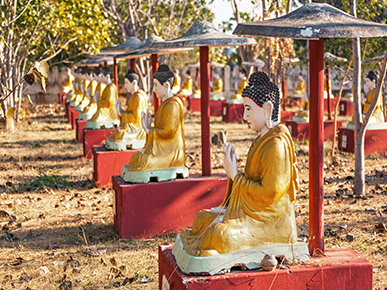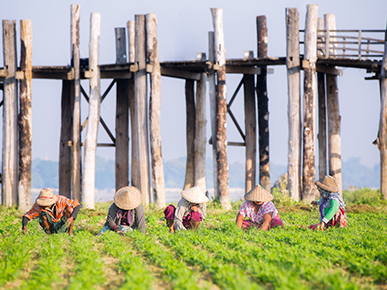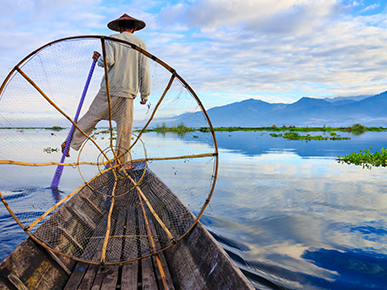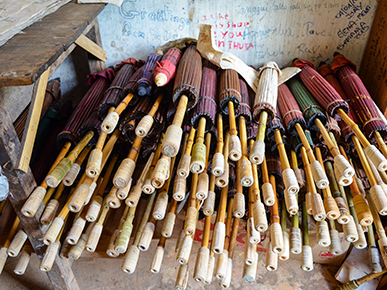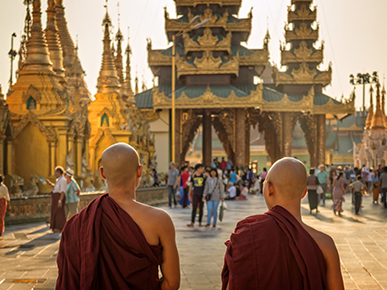Asian Frontiers :
Indo-Myanmar Itinerary
The recent changes in the border crossing laws resulted in a collaboration with our partner in Myanmar. Together we designed a 16 nights/17 days Indo-Myanmar itinerary. To know things firsthand, Kuntil Baruwa, Explorer at our Destination Knowledge Centre was sent to Kohima and then to Imphal from where he continued to the border town of Tamu on the Myanmar side. Tamu is from where our Myanmar partner will take over the ground arrangements from us.
In our Indo-Myanmar itinerary, start from KOLKATA (formerly Calcutta) the capital of the state of West Bengal in India’s East Coast. Kolkata is busy, chaotic, yet irresistibly charming with its neo-classical and Gothic architecture. An erstwhile trading post of the British East India company located by the River Hooghly, Kolkata is the largest city of Eastern India. Durga Puja which celebrates Shakti – the divine feminine of Hinduism- for 10 days during the month of October is the best time to visit. From Kolkata fly nonstop to Dimapur and continue by surface to KOHIMA the capital of the state of Nagaland where 96% of its population are Christians. Located at an altitude of 1500 metres (5000 feet) Kohima is scattered across several ridges and hill tops. Nagaland - home to 16 tribes of Tibeto-Burman origin- has remained largely unknown even to Indians. But thanks to the Hornbill Festival (01-10 December every year) the Nagas are slowly coming in contact with people from diverse backgrounds and contrasting life styles not only from within India but also overseas. The Hornbill Festival is when all the 16 Naga tribes gather in Kohima dressed up in their astonishing and beautiful finery. It is a great time to be in Kohima. The festive Christmas week is also a beautiful time to be here. From Kohima continue by surface to IMPHAL the capital of the state of Manipur where women have always been at the forefront whether conducting commerce or taking the initiative in socio-political issues. At the 500 year old Ima Kaithal (Mother’s Market) of Imphal, 4000 women (aged between 38-62) trade every single day selling everything from handicraft to fish, and from exotic fruits & vegetables to blue lotus flowers. Loktak Lake which is a day trip from Imphal is a nice precursor to the scenic Inle Lake of Myanmar. It is famous for its unique ecosystem called ‘Phumdi’ (a Manipuri word meaning floating mats of soil and vegetation) which are strong enough to sustain a house. Like Inle, Loktak is throbbing with life though tourism here is still very much in its infancy unlike Inle. Every November the 200 year old Govindjee Temple of Imphal comes alive with the ancient dance tradition of Raas Leela which celebrates the life and time of the Hindu God Krishna. It is a great time to be in Imphal. Govindjee Temple is not too far away from the Kangla Fort – a majestic citadel which was once the capital of the Manipuri monarchs.
From Imphal Valley climb up the steep hills to first reach MOREH on the Indian side and then enter TAMU on the Myanmar side after completing the immigration formalities. Post Lunch continue to KALE to overnight. Kale is a fascinating cultural mix - the town is split down the middle between the Chin ethnic community who are Christians and the Bamars, the dominant ethnic group of Mynamar who are Buddhist. There are said to be over 600 churches in Kale. Continue to MONYWA next morning where the forested hills fall away to farmland with its attractive villages. The Thanbodi Temple with its million Buddha images is the highlight here. From Monywa reach MANDALAY – the Spiritual Capital of Myanmar. There are many splendid pagodas, monasteries and the Royal Palace with its teak pavilions, throne rooms and halls. From Mandalay hop on a boat down the mighty Irrawaddy River to the pottery village of YANDABOO. In the nearby village of Pan No the community harness over a thousand water buffalo to cultivate their land. It was here in Yandaboo that the peace treaty which ended the First Anglo-Burmese war was signed in 1826. Assam and Manipur became British protectorates as a part of the treaty. Take another boatride from Yandaboo to arrive into BAGAN one of the world’s greatest archaeological sites. Between the year 1057 and 1287, the Kings of Bagan built 4450 Temples here out of which 2230 survive, a legacy of the Buddhist belief that to build a temple was to earn merit. Fom Bagan fly nonstop to Heho and continue by surface to the scenic INLE LAKE famous for its floating gardens and villages and the unique way of life of the locals which is based entirely on the freshwater lake which is 22 kms (14 miles) long and 10 kms (6 miles) wide. From Inle Lake return to Heho to fly nonstop to the last destination of our itinerary YANGON. With its wonderful array of colonial buildings, Yangon (formerly Rangoon) just like Kolkata from where the journey begins was a key erstwhile trading post of the British East India Company. Yangon is also famous for the Shwedagon Pagoda, the monumental golden Buddhist shrine. The city also has an eclectic range of museums, art galleries, restaurants and markets.
